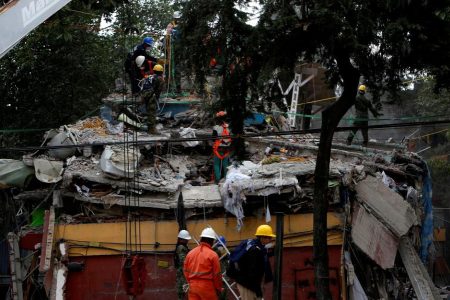MEXICO CITY, (Reuters) – Mexican rescuers yesterday laboured for a second night amid the rubble to save possible survivors of the country’s most lethal earthquake in a generation, including a girl trapped under a school in Mexico City, as the death toll exceeded 230.
Television stations broadcast live the painstaking, hours-long attempt to rescue the girl after crews at the school in the south of the city reported seeing her hand move. They threaded a hose through debris to get her water.

The girl’s name was not made public, but her family waited in anguish nearby. Rescuers moved slowly, erecting makeshift wooden scaffolding to prevent rubble from crumbling further and seeking a path to the child through the unstable ruins. They implored bystanders to be quiet to better hear calls for help. It was part of the careful search for dozens of victims feared buried beneath the Enrique Rebsamen school, where officials reported 21 children and four adults dead after Tuesday’s quake. Hundreds of buildings were destroyed.
“We have a lot of hope that some will still be rescued,” said David Porras, one of scores of volunteers helping the search at the school for children aged 3 to 14. “But we’re slow, like turtles,” he said.
By Wednesday morning, the workers said a teacher and two students had sent text messages from within the rubble. Parents clung to hope that their children were alive.
The magnitude 7.1 quake, which killed at least 93 people in the capital, struck 32 years to the day after a 1985 earthquake that killed thousands. Mexico is also still reeling from a powerful tremor that killed nearly 100 people in the south of the country less than two weeks ago.
On Wednesday afternoon, officials told bystanders to move back from the Plaza Condesa building which houses a well-known concert hall frequented by famous international acts and a popular bar in the upscale Condesa neighborhood.
The order sparked fears the massive building could collapse, just like an apartment block about 100 meters (yards) away where emergency crews spent Wednesday sifting though rubble. Throughout the capital, crews were joined by volunteers and bystanders who used dogs, cameras, motion detectors and heat-seeking equipment to detect victims who may still be alive.
Reinforcements began to arrive from countries including Panama, Israel and Chile, local media reported. In a statement, the U.S. Agency for International Development (USAID) said it was sending a Disaster Assistance Response Team to help, at the request of the Mexican government.
“The United States remains committed to helping our neighbors during this difficult time,” the statement said.
U.S. President Donald Trump spoke at length with Mexican President Enrique Pena Nieto on Wednesday, the White House said. On Tuesday, Trump had tweeted: “God bless the people of Mexico City. We are with you and will be there for you.”
Pena Nieto declared three days of mourning.
“The priority continues to be rescuing people from collapsed buildings and taking care of the injured,” he said. “Every minute counts.”
The president has been unusually visible since the two earthquakes, a sign of the political sensitivity of disaster relief less than a year before the next presidential election.
The government’s widely panned response to the 1985 quake caused upheaval in Mexico, which some credited with weakening the 71-year rule of the Institutional Revolutionary Party (PRI). Pena Nieto, the PRI’s first president since it lost power in 2000, hopes to elect a party successor next year.
On Wednesday, the president traveled to the state of Morelos, just south of the capital, where 71 people died, to survey damage. In Puebla State, site of the earthquake’s epicenter, at least 43 died.
The earthquake toppled dozens of buildings, tore gas mains and sparked fires across the city and other towns in central Mexico. Falling rubble and billboards crushed cars, and nearly 5 million homes, businesses and other facilities were without power at one point.
Although authorities and property owners will need time to fully assess the damage, initial reports suggest that collapses were limited mostly to buildings that predated the 1985 quake, after which stricter building codes were enacted.
But even wealthier parts of the capital, including the central Condesa and Roma neighborhoods, were badly damaged as older buildings buckled. Because bedrock is uneven in a city built on a drained lake bed, some districts weather quakes better than others.
“The central part of Mexico City, in the lake bed, is always going to be a complicated place to build,” said Rodrigo Suarez, chief operating officer at Mexico City-based apartment developer Hasta Capital. “These old buildings (may) survive an earthquake or two or three, but since they weren’t built to modern code, there’s always going to be a risk in major earthquakes.”
In Puebla, some 100 miles (158 km) southwest of the capital, parts of colonial-era churches crumbled. In the town of Atzala, a row of coffins lined the street outside a church where the roof collapsed, killing 11 worshipers inside.




